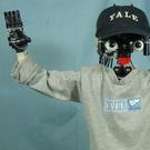August 24, 2012 report
Robot NICO learning self awareness using mirrors

(Phys.org)—Self awareness is one of the hallmarks of intelligence. We as human beings clearly understand that we are both our bodies and our minds and that others perceive us in ways differently than we perceive ourselves. Perhaps nowhere is this more evident than when we look in a mirror.
In so doing we understand that the other person looking back, is really the three dimensional embodiment of who we really are as a complete person. For this reason, researchers use something called the mirror test as a means of discerning other animals' level of self awareness. They put a mark of some sort on the face without the animal knowing it, then allow the animal to look in a mirror; if the animal is able to comprehend that the mark is on its own face, and demonstrates as much by touching itself where it's been marked, than the animal is deemed to have self awareness. Thus far, very few have passed the test, some apes, dolphins and elephants. Now, researchers at Yale University are trying to program a robot that is able to pass the test as well.
The robot's name is NICO, and has been developed by Brian Scassellati and Justin Hart, who together have already taught the robot to recognize where its arm is in three dimensional space to a very fine degree, a feat never before achieved with a robot of any kind. The next step is to do the same with other body parts, the feet, legs torso and of course eventually the head, which is the most critical part in giving a robot self awareness, which is the ultimate goal of the project.
Programming a robot to have self awareness is considered to be one of the key milestones to creating robots that are truly useful in everyday life. Robots that "live" in people's homes for example, would have to have a very good understanding of where every part of itself is and what it's doing in order to prevent causing accidental harm to housemates. This is so because the movements of people are random and haphazard, so much so that people quite often accidently bump into one another. With robots, because they are likely to be stronger, such accidents would be unacceptable.
Scassellati and Hart believe they are getting close and expect NICO to be able to pass the mirror test within the next couple of months. No doubt others will be watching very closely, because if they meet with success it will be a truly historic moment.
© 2012 Phys.Org




















